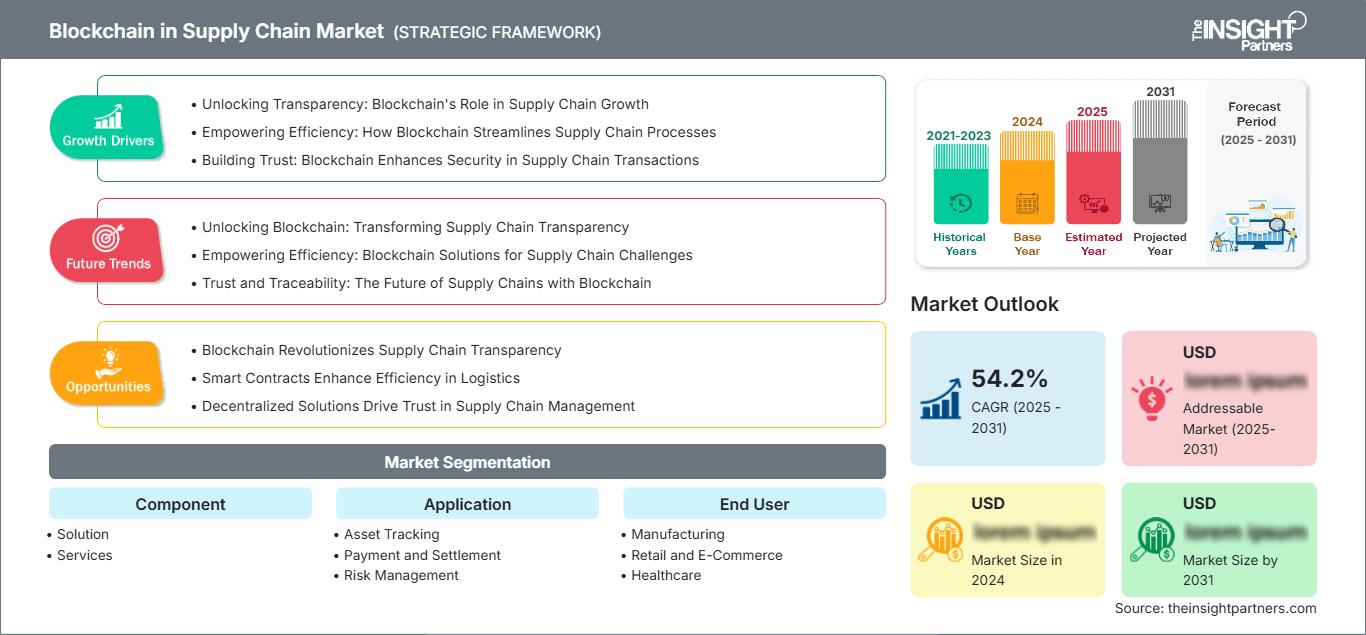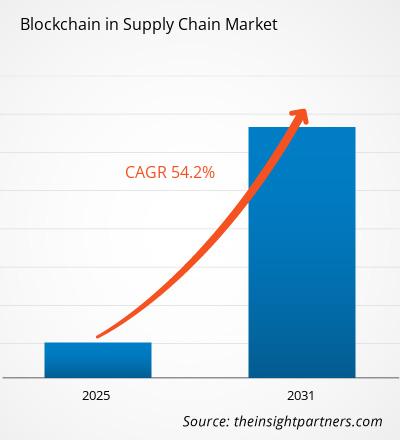サプライチェーン市場におけるブロックチェーンは、2025年から2031年にかけて年平均成長率(CAGR)54.2%を記録し、市場規模は2024年のXX百万米ドルから2031年にはXX百万米ドルに拡大すると予想されています。
本レポートは、コンポーネント(ソリューション、サービス)別に分類され、さらにアプリケーション(資産追跡、支払い・決済、リスク管理)に基づいて市場を分析しています。また、エンドユーザー(製造、小売・電子商取引、ヘルスケア、輸送、エネルギー・公益事業)別に市場を分析しています。これらの主要セグメントそれぞれについて、世界、地域、国レベルで包括的な内訳が提供されています。本レポートには、全セグメントの市場規模と予測が含まれており、値は米ドルで表示されています。また、主要プレーヤーの現在の市場状況に関する重要な統計情報とともに、一般的な市場動向と新たな機会に関する洞察も提供します。
レポートの目的
The Insight Partners によるレポート「サプライ チェーン市場におけるブロックチェーン」は、現在の状況と将来の成長、主な推進要因、課題、機会について説明することを目的としています。これは、次のようなさまざまなビジネス ステークホルダーに洞察を提供します。
- 技術プロバイダー/メーカー: 進化する市場動向を理解し、潜在的な成長機会を把握することで、情報に基づいた戦略的決定を下すことができます。
- 投資家: 市場の成長率、市場の財務予測、バリュー チェーン全体に存在する機会に関する包括的なトレンド分析を実施します。
- 規制機関: 市場の乱用を最小限に抑え、投資家の信頼と信用を維持し、市場の完全性と安定性を維持することを目的として、市場におけるポリシーと警察活動を規制します。
サプライチェーン市場セグメンテーションコンポーネントにおけるブロックチェーン
- ソリューション
- サービス
アプリケーション
- 資産追跡
- 支払いと決済
- リスク管理
エンドユーザー
- 製造業
- 小売業と電子商取引
- ヘルスケア
- 運輸業
- エネルギーと公益事業
レポートの一部、国レベルの分析、Excelデータパックなどを含め、スタートアップ&大学向けに特別オファーや割引もご利用いただけます(無償)
サプライチェーン市場におけるブロックチェーン: 戦略的洞察

- このレポートの主要な市場動向を入手してください。この無料サンプルには、市場動向から見積もりや予測に至るまでのデータ分析が含まれます。
サプライチェーン市場におけるブロックチェーンの成長要因
- 透明性の解放:サプライチェーンの成長におけるブロックチェーンの役割
- 効率性の向上:ブロックチェーンがサプライチェーンのプロセスを効率化する方法
- 信頼の構築:ブロックチェーンがサプライチェーン取引のセキュリティを強化する
サプライチェーン市場におけるブロックチェーンの将来動向
- ブロックチェーンの解放:サプライチェーンの透明性の変革
- 効率性の向上:サプライチェーンの課題に対するブロックチェーンソリューション
- 信頼とトレーサビリティ:ブロックチェーンによるサプライチェーンの未来
サプライチェーン市場におけるブロックチェーンの機会
- ブロックチェーンがサプライチェーンの透明性に革命を起こす
- スマートコントラクトが物流の効率性を高める
- 分散型ソリューションサプライチェーン管理における信頼の促進
サプライチェーン市場におけるブロックチェーンの地域別分析
The Insight Partnersのアナリストは、予測期間を通じてサプライチェーンにおけるブロックチェーン市場に影響を与える地域的な動向と要因を詳細に解説しています。このセクションでは、北米、ヨーロッパ、アジア太平洋、中東・アフリカ、中南米におけるサプライチェーンにおけるブロックチェーン市場のセグメントと地域についても解説しています。
サプライチェーン市場レポートにおけるブロックチェーンの範囲
| レポート属性 | 詳細 |
|---|---|
| の市場規模 2024 | US$ XX million |
| 市場規模別 2031 | US$ XX Million |
| 世界的なCAGR (2025 - 2031) | 54.2% |
| 過去データ | 2021-2023 |
| 予測期間 | 2025-2031 |
| 対象セグメント |
By コンポーネント
|
| 対象地域と国 | 北米
|
| 市場リーダーと主要企業の概要 |
|
サプライチェーン市場におけるブロックチェーンのプレーヤー密度:ビジネスダイナミクスへの影響を理解する
サプライチェーンにおけるブロックチェーン市場は、消費者の嗜好の変化、技術の進歩、製品メリットへの認知度の高まりといった要因によるエンドユーザーの需要増加に牽引され、急速に成長しています。需要が高まるにつれ、企業は提供内容を拡大し、消費者ニーズを満たすためのイノベーションを推進し、新たなトレンドを活用しており、これが市場の成長をさらに加速させています。

- 入手 サプライチェーン市場におけるブロックチェーン 主要プレーヤーの概要
主なセールスポイント
- 包括的なカバレッジ:本レポートは、サプライチェーン市場におけるブロックチェーンの製品、サービス、タイプ、エンドユーザーの分析を包括的に網羅し、包括的な展望を提供しています。
- 専門家による分析:本レポートは、業界の専門家とアナリストの深い理解に基づいて編集されています。
- 最新情報:本レポートは、最新の情報とデータトレンドを網羅しているため、ビジネスの関連性を保証します。
- カスタマイズオプション:本レポートは、特定のクライアントの要件に対応し、ビジネス戦略に適切に適合するようにカスタマイズできます。
したがって、サプライチェーン市場におけるブロックチェーンに関する調査レポートは、業界のシナリオと成長の見通しを解読し理解するための先導役となります。いくつかの正当な懸念事項があるかもしれませんが、本レポートの全体的なメリットはデメリットを上回る傾向があります。
- 過去2年間の分析、基準年、CAGRによる予測(7年間)
- PEST分析とSWOT分析
- 市場規模価値/数量 - 世界、地域、国
- 業界と競争環境
- Excel データセット
最新レポート
お客様の声
購入理由
- 情報に基づいた意思決定
- 市場動向の理解
- 競合分析
- 顧客インサイト
- 市場予測
- リスク軽減
- 戦略計画
- 投資の正当性
- 新興市場の特定
- マーケティング戦略の強化
- 業務効率の向上
- 規制動向への対応




















 無料サンプルを入手 - サプライチェーン市場におけるブロックチェーン
無料サンプルを入手 - サプライチェーン市場におけるブロックチェーン